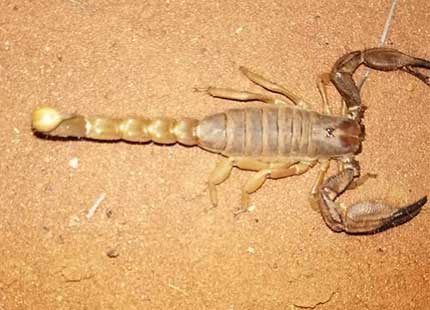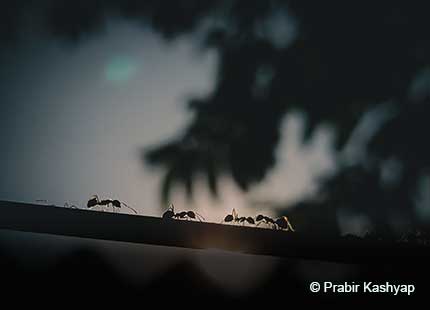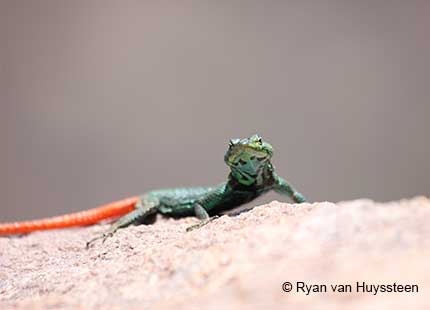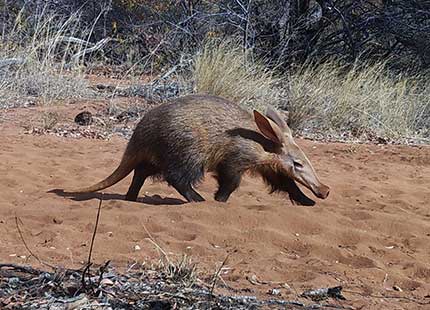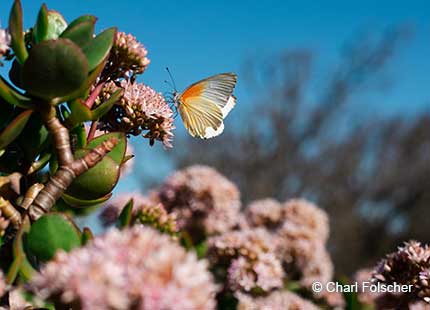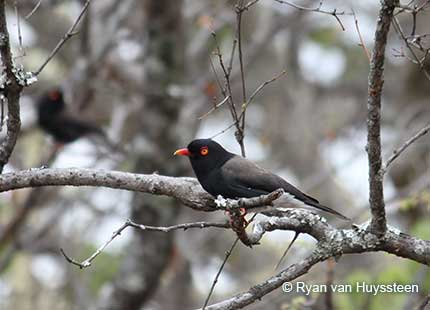Soutpansberg
Protected area

Conserving the Soutpansberg Mountains
The Soutpansberg Mountains within the Limpopo Province are South Africa’s most northern mountain range, full of mystery and magic, with thousands of species found nowhere else on Earth (endemic species).
Furthermore, the Soutpansberg is recognised as:
- A Priority Conservation Area by the South African National Biodiversity Institute (SANBI)
- A Critical Biodiversity Area by the Limpopo Department of Economic Development, Environment and Tourism (LEDET), the provincial conservation authority
- A Strategic Water Source Area by WWF-South Africa
- Part of the National Protected Area Expansion Strategy by South Africa’s Department of Forestry, Fisheries, and Environment (DFFE)
- Lying within the UNESCO Vhembe Biosphere Reserve, proclaimed in 2009
1.8k
species
22k
hectares
protected
11
pack members

The unique biodiversity of the Soutpansberg
There are 18 recognised centres of endemism in southern Africa – localised areas with high species diversity found nowhere else. The Soutpansberg is one of these and has the highest plant diversity of all these centres, home to various rare and threatened plant species. Approximately 3,000 vascular plant species are known to occur in the 6,800 km² that makes up the Soutpansberg Mountains. Six biomes are found in the mountains: forest, thicket, savannah, grassland, fynbos, and wetland.
This area is home to
A centre of cultural heritage
The rock art of the Soutpansberg is outstanding, with some of the finest examples of Khoekhoe and San paintings found at the Sand River Shelter on the EWT’S Medike Nature Reserve. To date, 41 sites have been documented in the Soutpansberg, with many still undescribed.
- The area’s cultural heritage is predominantly that of the vhaVhenda and vhaTsonga people. Their vibrant traditional culture of storytelling and production of rich arts and crafts are still practised today. The vhaVenda artists are among the finest in Africa, and their original works are collected worldwide.
- There is a wealth of indigenous knowledge in the area within the following disciplines:
- Potters (Mukhondeni and Mashmba are the most well-known)
- VhaVenda drum makers (such as Phineas Masuvhelele)
- Textile co-operatives (most of these are women’s projects such as Tsonga textiles and Twananani)
- Traditional Shangaan and vhaVenda dress manufacturers
- Beadworkers
- Cultural performing artists (such as the Bungeni women’s group)
- Cultural village experiences (such as the Luvhola cultural village and vhaTsonga cultural experience)
Since the arrival of the first people of European descent in 1821, the culture in and around the Soutpansberg Mountains is also influenced by other communities, such as the Afrikaner, British, German, Portuguese, Indian, Swiss, and Scottish.
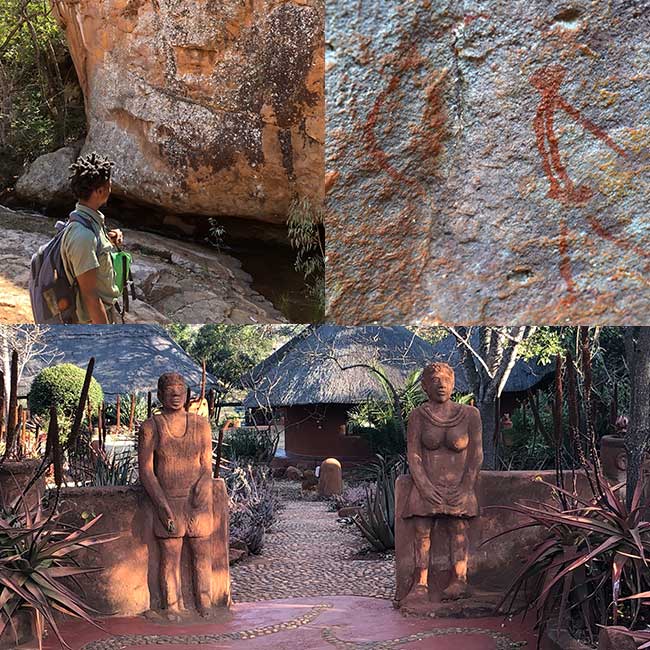

Threats facing the Soutpansberg
The Soutpansberg Mountains currently receive little formal conservation attention, with less than 1% of the area formally conserved in nature reserves. It is severely threatened by overexploitation of natural resources, invasive alien plant species, and habitat destruction through developments.
The key threats to the unique biodiversity of the Soutpansberg Mountains include:
-
-
- Illegal killing of wildlife for the local bushmeat trade and for skins of species such as Leopard (Panthera pardus). Leopards have shown a 66% decline in population density over the past eight years, mostly due to illegal snaring
- Illegal killing of wildlife for the trade in animal products
- Illegal and unsustainable harvesting of medicinal plants and the uncontrolled collection of firewood
- Ongoing illegal sand mining in the Sand River for the construction industry
- Illegal fish poaching
- Illegal clearing of indigenous forests for agricultural development
- Bush encroachment
- The spread of invasive alien plants, especially within the riparian zones (on the banks of rivers), threatens freshwater biology, water quality, and the region’s water security.
-
Most of these threats are strongly linked to the lack of economic opportunity for the rural communities surrounding the western Soutpansberg. The lack of socio-economic development results in communities relying heavily on extracting natural resources directly from their surroundings to survive.

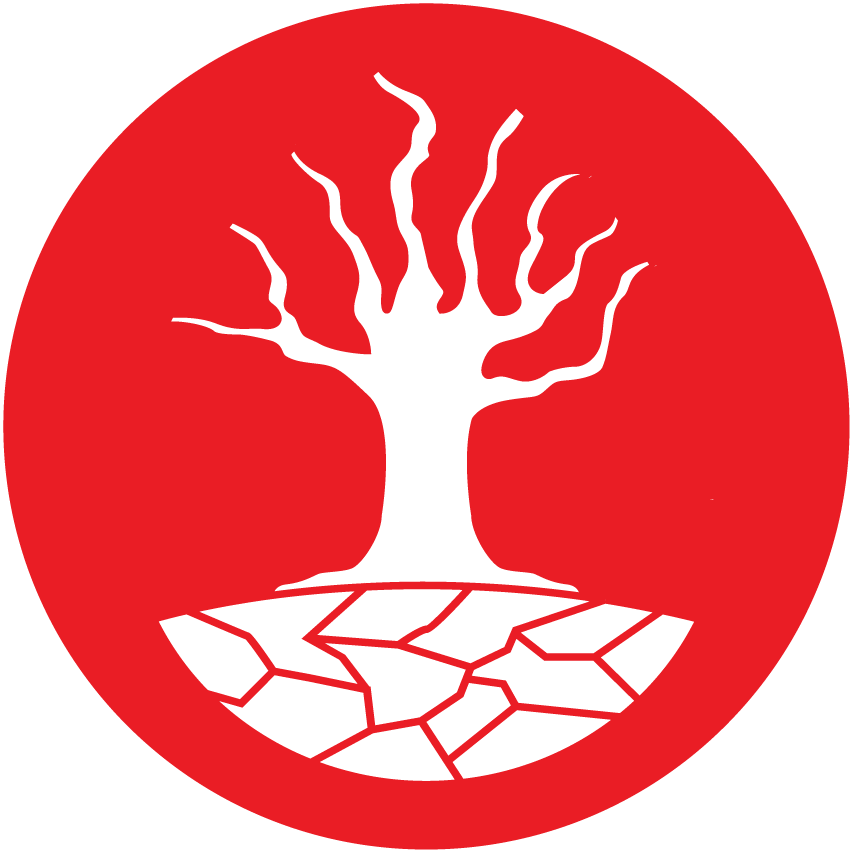



How we conserve the Soutpansberg
The EWT addresses threats to species and their habitats across the Soutpansberg by promoting formal protection of the area and facilitating the development of local jobs in the ‘green’ job sector. We actively engage the communities and landowners in and around the Soutpansberg to build capacity, generate awareness, and create resilience against environmental change. We aim to collaboratively build a community of conservation practice across the region to benefit the Soutpansberg’s natural resources, wildlife, and current and future generations of people dependent on the area.





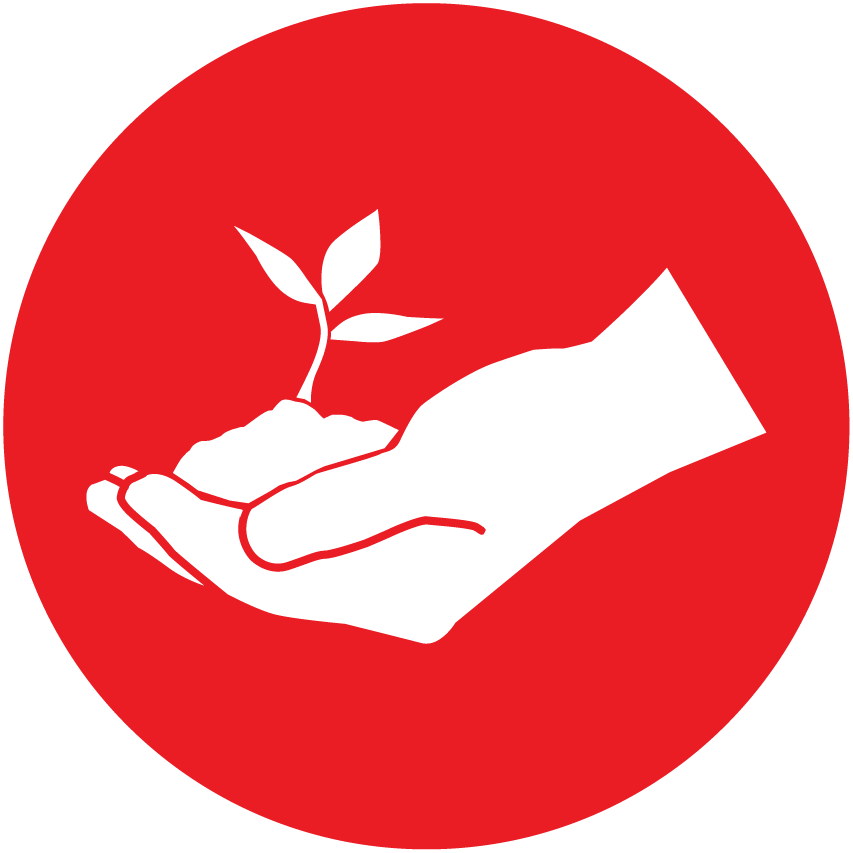
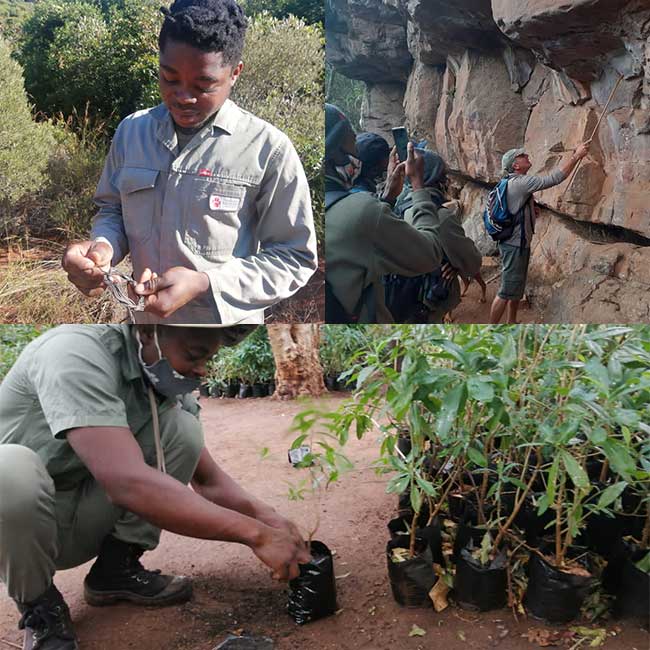

A far-reaching vision for the Soutpansberg Protected Area
Effective Management of the EWT’s Medike Nature Reserve
In 2017, the EWT purchased Medike Nature Reserve thanks to a generous donation from The Roberts Family in Australia. With further support from The Rainforest Trust, additional properties, the Moss and Gawsworth, were purchased in 2018, expanding the EWT footprint to 2,733 ha of pristine mountain wilderness.
Medike Nature Reserve is home to several iconic, rare, endemic, and Endangered species, and we are conserving these and the fragile mountain ecosystem through an active anti-poaching unit, ongoing monitoring of species through a camera trap grid, and actively managing threats to the ecosystems such as bush encroachment and invasive alien plants. For more information, please visit our Medike Destination page
Protected Area expansion and management
The EWT has embarked on a long-term project to realise our dream of establishing the Soutpansberg Protected Area (SPA) to protect the largely pristine mountainous environment within the western Soutpansberg’s Sand River Gorge. We are working with landowners and communities to establish one large, protected area corridor through the Biodiversity Stewardship process. Biodiversity stewardship is based on voluntary commitments from landowners to manage their properties in a conservation-friendly manner. Different agreement types support conservation and sustainable resource use, including the formal proclamation of land under the Protected Areas Act, providing long-term protection of properties. We are engaging landowners on the mountain to enter into one of these agreements to protect and manage their land as the custodians of biodiversity.
This network will conserve the region’s unique biodiversity, including Critically Endangered, Endangered, and locally endemic species of animals and plants; provide wildlife corridors for range expansion; ensure the sustained integrity of the water resources and catchments; improve land management; reduce human-wildlife conflict; and expand sustainable livelihood options for the local communities in the ecotourism and conservation sectors. Providing jobs will also stimulate growth in the local industries supporting these sectors and reduce the pressure on the surrounding environment.

Ecotourism Development
The Soutpansberg Mountain offers a unique experience to all visitors. The scenic beauty, cultural heritage, and diversity of habitats and species will keep any nature enthusiast enthralled for days. The EWT is working with neighbouring landowners to develop a network of hiking trails called The Old Salt Trail, which will also double up as anti-poaching patrol routes. Some EWT Rangers have been trained as guides through the Field Guide Association of South Africa and will now serve as guides on the Old Salt Trail. The trail network will also open up the opportunity for trail running events such as Soutpansberg Mountain Marathon and traversing expeditions on 4X4 tracks.
The long-term vision is that this project will catalyse a thriving ecotourism initiative, bringing visitors to the mountain in an ecologically sensitive way. They can experience the exceptional beauty and biodiversity on offer while gaining knowledge from the trail guides and supporting local socio-economic development within a protected environment.
Habitat restoration
SPA Water Conservation and Alien and Invasive Species Control
South Africa is one of the world’s 30 most arid countries. The relatively pristine western Soutpansberg Mountain is a Strategic Groundwater Source Area containing an upper catchment with wetlands and streams feeding into the Sand and Nzhelele Rivers within the Limpopo Basin. These essential water resources contribute to economic growth in the country by feeding downstream agriculture and communities. Invasive alien trees such as Eucalyptus and Black Wattle negatively impact water resources, especially when they are situated near watercourses. Invasive alien plants have a detrimental impact on riverine habitat and water resources. Our SPA team includes a dedicated team of rangers working on clearing these invasive species to restore water by replenishing groundwater sources and restoring habitats for threatened species.
Strategic conservation of medicinal plants
The Soutpansberg is home to plants with medicinal properties that are sought-after for use in traditional healing practices. The EWT strives to conserve these plants in collaboration with partners in the Soutpansberg and other regions whilst ensuring that those who depend on them for traditional medicine can legally access the species they need.
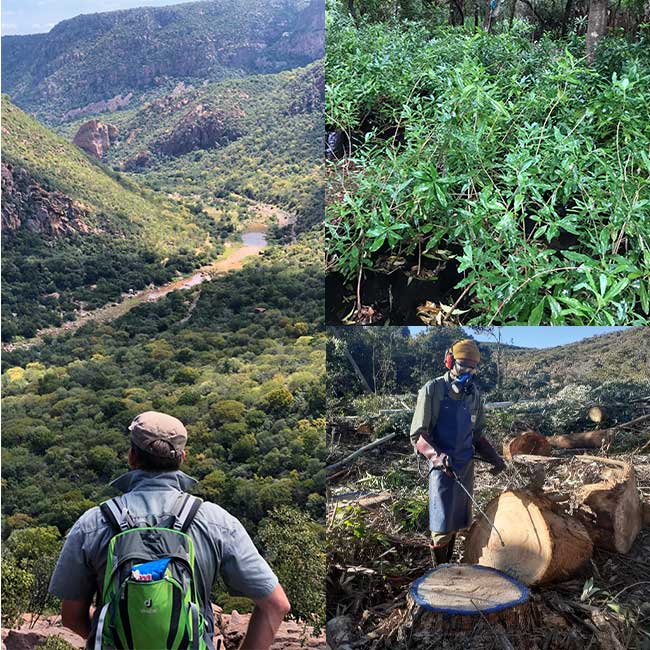
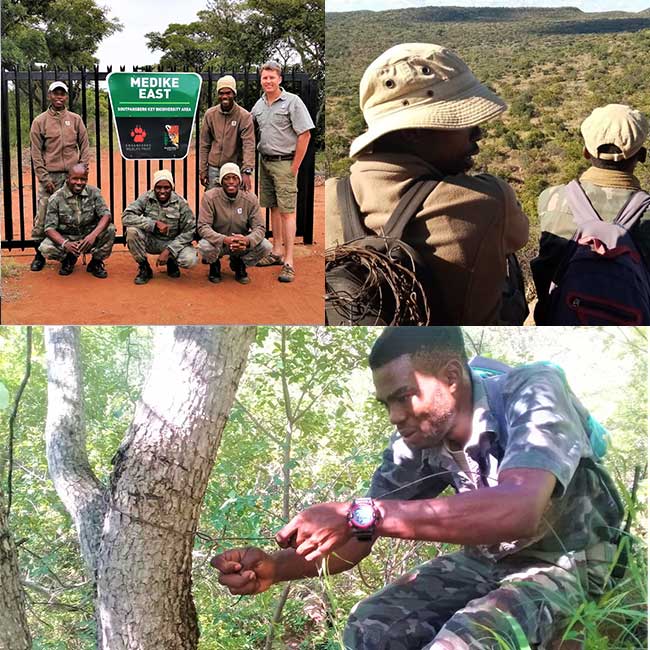
Anti-poaching
Our field rangers continue to perform ongoing conservation work on the reserve. Their operations include a dedicated anti-poaching unit that conducts regular patrols to remove snares and fishing nets and escorts intruders off the property. In 2021, the field rangers removed 70 snares from the property, a reduction from the 94 snares we removed two years ago, showing that our anti-poaching work is paying dividends in protecting wildlife on the reserve. The team also conducts anti-poaching snare patrols on other properties where snaring is known to be a big issue, and they have already removed more than 66 snares from within these properties.
Mammal Monitoring Project
The EWT has set up a camera trap grid across Medike Nature Reserve, contributing data to our Mammal Monitoring Project. This grid expands a current long-term monitoring grid implemented across numerous properties on the western Soutpansberg by Durham University’s Primate and Predator Project. The cameras on the grid give us valuable insight into mammals on Medike, particularly Leopards, and establish a long-term monitoring database for research and assessing ecosystem health.
The cameras also bring our attention to snared animals, which we can then assist.

Stories of Success for
the soutpansberg
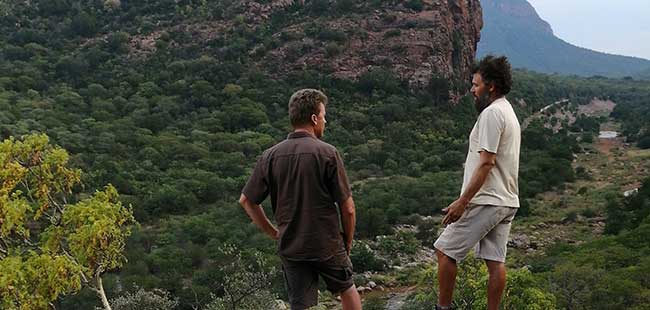
Western Soutpansberg Nature Reserve in the making
The first phase of the SPA Protected Area project focused on the western Soutpansberg. Following biodiversity assessments, the western Soutpansberg properties identified for Biodiversity Stewardship due to their unique biodiversity value all qualified to be protected as a Nature Reserve, the highest level of protection. The SPA project was instrumental in driving the formation of the collective Western Soutpansberg Nature Reserve, comprising multiple privately owned properties. Establishing a large, protected area along the western Soutpansberg will secure vital habitat for many endemic and threatened species and strategically important water resources for generations to come. This protected area will also reduce threats such as land-use change and attract visitors to ecotourism initiatives; create sustainable jobs, and drive nature-based economic activity in this pristine, awe-inspiring landscape.
In August 2020, the first Special General Meeting of the newly formed Western Soutpansberg Nature Reserve Association took place. The Association, consisting of 21 landowners, including the EWT, will be assigned as the Management Authority once the Western Soutpansberg Nature Reserve is proclaimed. We have received landowner resolutions to declare the nature reserve from 17 registered landowners, comprising 31 properties covering an area of 22,000 ha. We submitted the request to become a nature reserve to the Limpopo Department of Economic Development, Environment and Tourism (LEDET) at the end of June 2021, which the MEC of LEDET subsequently approved, and a signed Notice of Intent to Declare a Nature Reserve was published in the provincial Gazette on 3 December 2021.
Further expansion is set to occur, with additional properties coming on board. The project will continue to focus on the formal proclamation and expansion of the Western Soutpansberg Nature Reserve and further afield across the Vhembe Biosphere Reserve. This conservation corridor may one day connect the western Soutpansberg with Tuli Block in Botswana and Tuli with northern Kruger via a Limpopo River corridor in a broader vision for the region.
This work is made possible by the Coca-Cola Foundation’s Replenish Africa Initiative (RAIN), Fondation Franklinia, Rainforest Trust, and ZZ2.
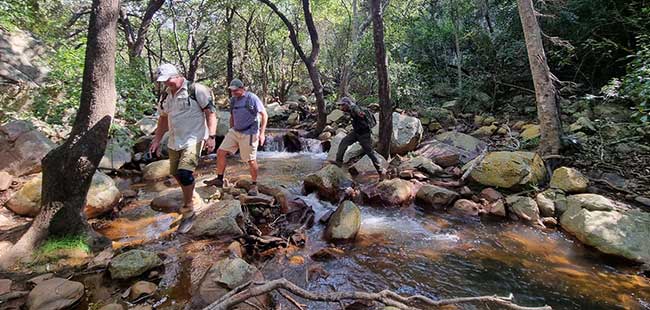
The Old Salt Trail
The western Soutpansberg lends itself well to ecotourism development. The high scenic value, changing habitats, fascinating rock art, and many plants and animals on the mountain make it an attractive destination, especially for hikers wanting to explore the mountain on foot.
With funding from the F E van Pletzen/L Steynburg Trust, we have worked closely with neighbouring landowners to develop a multi-day hiking trail across the western Soutpansberg. The trail starts and finishes at Medike Nature Reserve. The trail is a true slack-packing delight, with challenging hikes guided by the EWT’s local, FGASA-qualified apprentice field guides. At the end of each day, hikers are rewarded with wonderful accommodation and hospitality at each of the lodges along the route. Read more here for a more detailed account of this exciting new trail.
This work is made possible by the F E van Pletzen/L Steynberg Trust
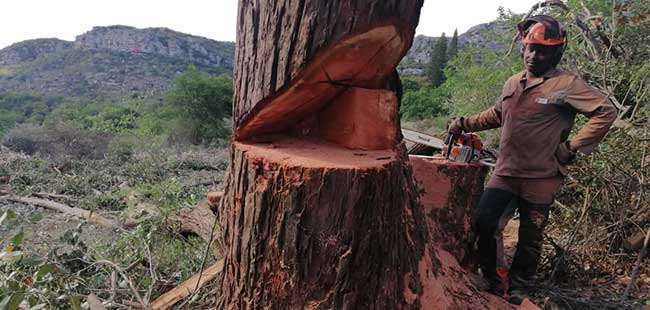
Clearing out the aliens
Since work began in August 2018, our team has cleared over 58 ha of dense invasive alien trees from within sensitive water catchments, replenishing over 12 million litres of water back into the environment every year. Based on our impact, in August 2022, the Fondation Franklinia provided additional funding to continue this vital work for another two years.
This work was made possible by the Coca-Cola Foundation’s Replenish Africa Initiative (RAIN) and Fondation Franklinia.
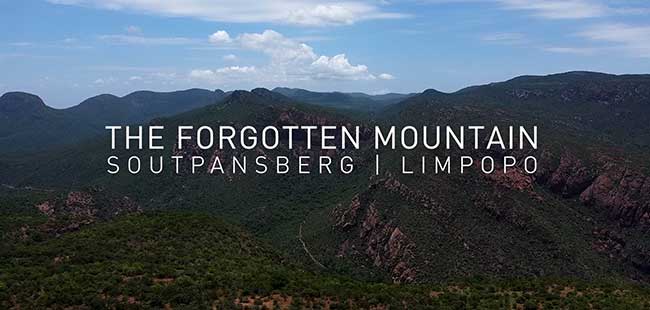
The Lesoba Difference
Lesoba Difference, an award-winning integrated marketing communications agency, produced an inspirational video of the Soutpansberg, shared widely by supporters and partners, including the Coca-Cola Foundation’s Replenish Africa Initiative (RAIN). The video profiles several landowners and the EWT’s Medike Mountain Reserve staff and focuses on the invaluable role the mountain plays in the lives of those who live and depend on it, as well as the story of how the western Soutpansberg is being conserved through biodiversity stewardship and other initiatives underway.
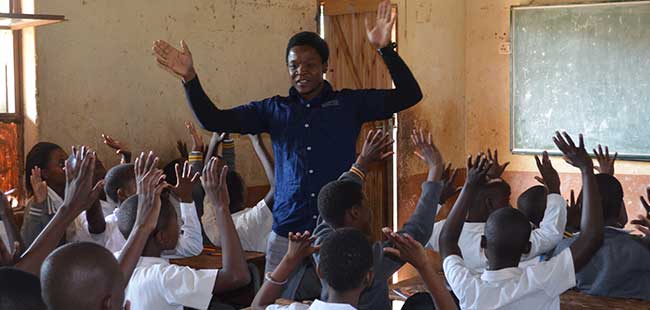
Making it rain in local schools
Our workshops with local community schools have been a core activity of the Soutpansberg Water Conservation Project, funded by the Coca-Cola Foundation’s Replenish Africa Initiative (RAIN). The workshops complemented our water conservation work (through biodiversity stewardship and alien vegetation clearing on the mountain) by teaching local school children about the importance of water conservation. We used the workshops to educate children about hygiene and the importance of washing hands, especially with the onset of COVID-19. We facilitated 15 water, sanitation, and hygiene (WASH) sessions at three schools in villages adjacent to the Soutpansberg. Over 470 learners and 16 teachers participated, well-exceeding our target of 400 children. Children also received Personal Protective Equipment (PPE) during the COVID-19 pandemic, and we installed WASH handwashing facilities in their classrooms.
As part of our commitment to empowering local communities, we partnered with Sumbandila Scholarship Trust, initiating a pilot reading club at the local rural primary school. Three volunteers also visited Pharani School daily for over a week to help learners with their reading and writing skills.
This work was made possible by the Coca-Cola Foundation’s Replenish Africa Initiative (RAIN)
What you can do to help us conserve the Soutpansberg Protected Area
Donate to save the Soutpansberg
You can become an investor in our Protected Area Expansion project in the western Soutpansberg. Your conservation legacy in the Soutpansberg will ensure that this forgotten mountain’s unique wildlife will continue to thrive for generations to come. Please email us for more information on how you can support the development of South Africa’s most exciting new conservation area.
Share some of your time and skills with us
As we continue to develop the Soutpansberg Protected Area, we may need help volunteers can assist with, such as removing invasive alien plant species. If you’d like to offer your assistance, please email us.

